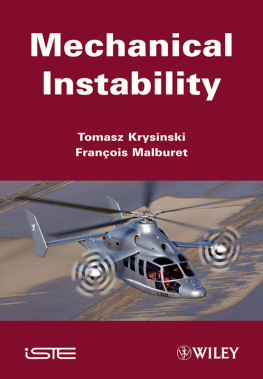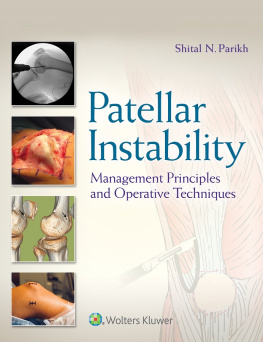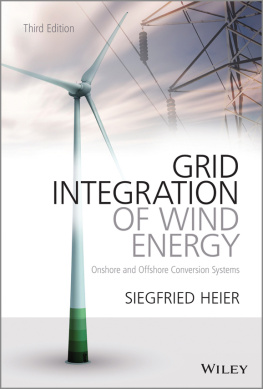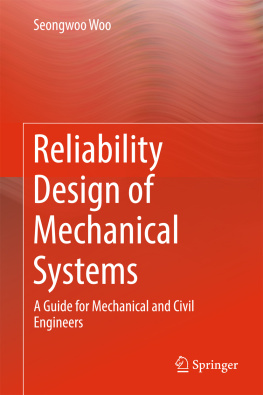Table of Contents

First published 2011 in Great Britain and the United States by ISTE Ltd and John Wiley & Sons, Inc. Adapted and updated from Instabilit mcanique published 2009 in France by Hermes Science/Lavoisier LAVOISIER 2009
Apart from any fair dealing for the purposes of research or private study, or criticism or review, as permitted under the Copyright, Designs and Patents Act 1988, this publication may only be reproduced, stored or transmitted, in any form or by any means, with the prior permission in writing of the publishers, or in the case of reprographic reproduction in accordance with the terms and licenses issued by the CLA. Enquiries concerning reproduction outside these terms should be sent to the publishers at the undermentioned address:
| ISTE Ltd | John Wiley & Sons, Inc. |
| 27-37 St Georges Road | 111 River Street |
| London SW19 4EU | Hoboken, NJ 07030 |
| UK | USA |
| www.iste.co.uk | www.wiley.com |
ISTE Ltd 2011
The rights of Tomasz Krysinski and Franois Malburet to be identified as the authors of this work have been asserted by them in accordance with the Copyright, Designs and Patents Act 1988.
Library of Congress Cataloging-in-Publication Data
Krysinski, Tomasz.
[Instabilit mcanique. English]
Mechanical instability/Tomasz Krysinski, Franois Malburet.
p. cm.
Includes bibliographical references and index.
ISBN 978-1-84821-201-5
1. Dynamics. 2. Mechanics, Applied. 3. Mechanical engineering. 4. Stability. 5. Vibration. I. Malburet, Franois. II. Title.
TA352.K7913 2011
620.1--dc22
2010042672
British Library Cataloguing-in-Publication Data
A CIP record for this book is available from the British Library
ISBN 978-1-84821-201-5
In a previous work, Mechanical vibrations Origin and control , published in 2003, Tomasz Krysinski, Dynamics Specialist, former Head of the Vibration and Internal Noise Department at Eurocopter Engineering and Design Department, and Franois Malburet, Teacher-Researcher at the Ecole nationale suprieure darts et mtiers of Aix-en-Provence, analyze the forced response of deformable mechanical systems subjected to periodic vibratory forces as well as to the dynamic optimization methods, and active and passive antivibration devices designed to limit the related effects.
In this work, which supplements the preceding one, the same authors are interested in the stability of mechanical systems, that is in their free response when they are moved away from their equilibrium position subsequent to a disturbance.
After a brief reminder of the main methods of analysis of the dynamic stability of systems, the authors highlight the fundamental difference in kind between the forced vibration resonance phenomena of mechanical systems subjected to an imposed excitation, and the instability phenomena which characterize their free response. If both types of phenomenon may lead to great deformation amplitudes and fatigue damage to the structure, the unstable phenomena are potentially much more hazardous since they may lead to sudden destruction of the structure in the event of divergent oscillations.
Sometimes also, unstable dissipative systems are subjected to self-sustained oscillations initially divergent but which saturate due to system behavior nonlinearities, thus resulting in a periodic permanent rating termed limit cycle. This is probably why the resonance phenomena and instabilities are sometimes mistaken for each other although the relevant analysis methods and mechanisms are very different, such as shown by the authors through the numerous examples presented.
The authors devote an entire chapter to the analysis of the phenomenon known as ground resonance of helicopters, which is in fact a potentially destructing self-sustaining instability resulting from coupling between the lag motion of the rotor blades and the motion of the aircraft standing on its landing gear.
Dynamic adaptation of the structure ensures the stability of the phenomenon by selecting the stiffness and damping characteristics for the landing gear, and lag adapters in order to correctly position the eigenfrequencies of the fuselage standing on its landing gear, and the blade lag eigenfrequency by preventing mode crossing within the normal rotor speed operating range while providing the damping necessary for the system stability (Colemans criterion).
Active control of ground resonance (and air resonance) is then approached. It consists in controlling the fuselage roll oscillations, measured by means of accelerometers placed in the structure, through the rotor main servocontrols which directly act on the cyclic pitch and hence on the blade flapping response, and indirectly on the lag, through the inertial coupling induced by the Coriolis forces.
The next chapter is devoted to the stability of drive shafts of rotating machines, and especially to a form of instability which is expressed through appearance of self-sustained bending vibrations on nonsynchronous frequencies of the shaft rotational speed, and which often lead to a limit cycle resulting from saturation of the forces. The authors show that the energy which supplies the vibrations originates from an external source and, and that such instability is related to the presence of damping internal to the rotating system whereas the original external damping reduces the risk of instability.
The last chapter concerns the problems of stability which may result from the interaction of a fluid with a flexible structure whose deformations change the fluid flow. Such aeroelastic coupling may give rise to self-sustained oscillations whose amplitude increases upon every cycle until their divergence leads to failure of the structure. In other cases, a limit cycle will be reached when there is an energy equilibrium state characterized by oscillation amplitude such that the energy dissipated by the structure compensates for the external energy supply.
Such flutter phenomena concern a substantial number of structures subjected to the effect of wind, like engineering structures, bridges, buildings and electric line cables, airplane wings or else helicopter blades and several cases which are approached in that chapter.
Whirl flutter of the rotors of tilting rotor convertible craft is the subject of a special study which details the relevant mechanisms and shows the effect of all system characteristics on the critical speed at which instability occurs.
We obviously recommend reading of this work, fruit of the collaboration between an industrial engineer and a university teacher, to all people who wish to deepen their knowledge as regards rotary wing dynamics.
Philippe ROESCH
VP Technology & Product Innovation
Eurocopter
The unstable behavior of structures has always constituted a substantial concern for designers. A simplified definition would consist in saying that the equilibrium of a dynamic system is stable when it remains close to its equilibrium position after any disturbance. Conversely, the system is unstable when it tends to leave its equilibrium position after such a disturbance. This definition will be specified and extended in .
The unstable behavior of structures caused much destruction in several industrial sectors, whether in naval construction, mechanical construction, land construction or air construction. In this foreword, we propose several examples of damage caused by instabilities:
flutter of airplane stabilizers;
whirl flutter of rotors;
Next page












